Spinach Bread with Parmesan: A Bread Machine Miracle
Sneak Peek: Spinach Bread with Parmesan features a prominent caramelized onion flavor (without the work of actually caramelizing onions) paired with overtones of Parmesan cheese. Tiny bits of spinach add color and freshness without turning the bread green. Use a bread machine to mix and knead the dough, then bake it in your oven for a superior crust, well-arranged crumb, and a beautiful appearance.
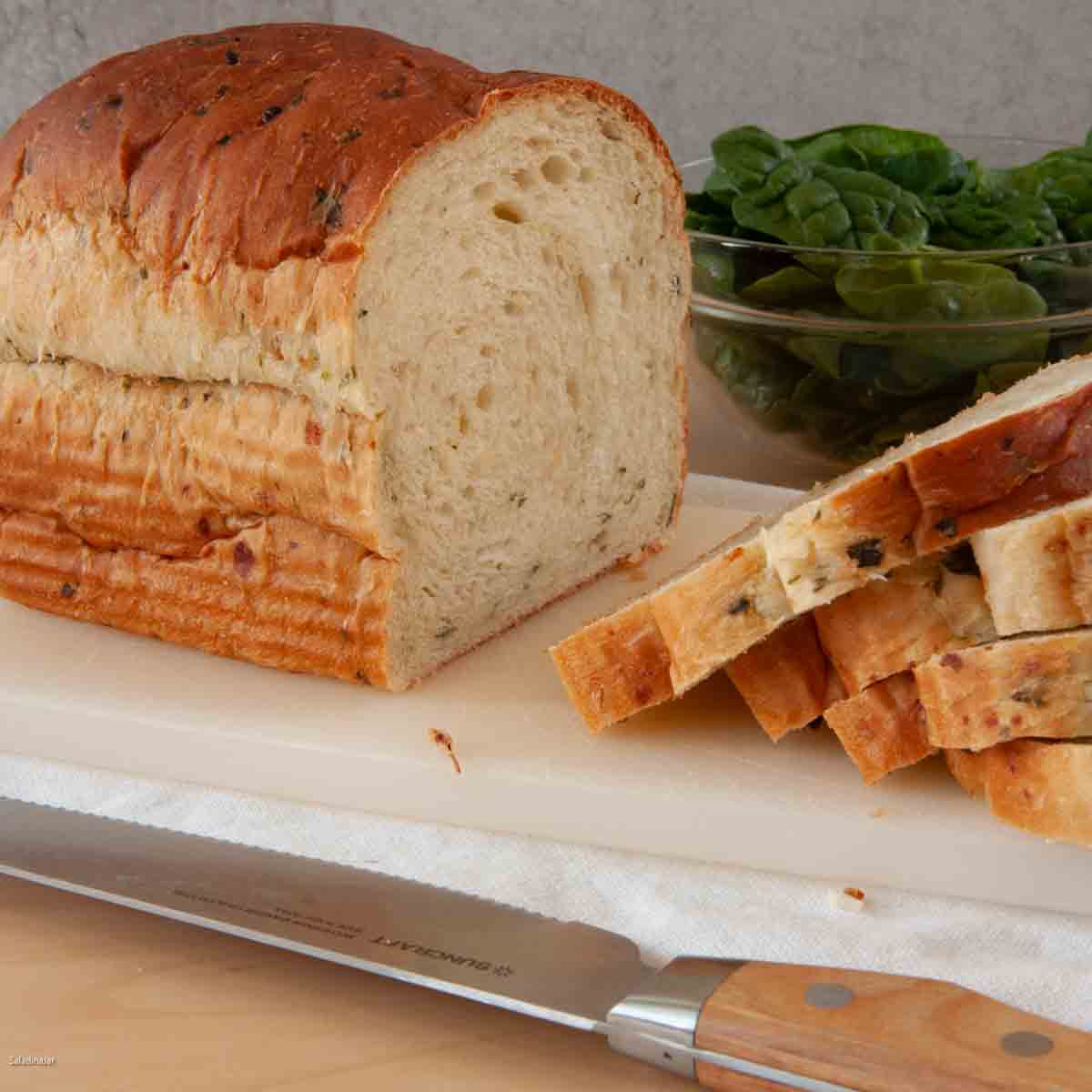
Are you looking for a bread recipe that’s out of the ordinary but easy to make? With the convenience of a bread machine (or a stand mixer–see notes in the recipe for details), you’ll find the process as enjoyable as the outcome. This Spinach Parmesan Bread is perfect for jazzing up your sandwiches or simply enjoying with a dab of butter or, even better, browned butter.
Three Reasons Why You Should Add This Bread to Your Collection
- You only need ¼ cup of fresh spinach; it’s a great way to finish off the bag in your fridge. The spinach flavor is not prominent.
- The caramelized onion flavor is perfect for ham or turkey sandwiches.
- The light and fluffy texture, along with the onion and cheese flavors, is a memorable combination you will enjoy eating out of hand. Good with raspberry jelly, too.
Dig out your bread machine and get ready to bake a loaf that promises a delightful twist on your everyday bread. As usual, the recipe directions are for mixing and kneading the dough in a bread machine, then shaping by hand and baking in a conventional oven. See the recipe notes for directions for making this recipe by hand or with a stand mixer.
Ingredients and Substitutions
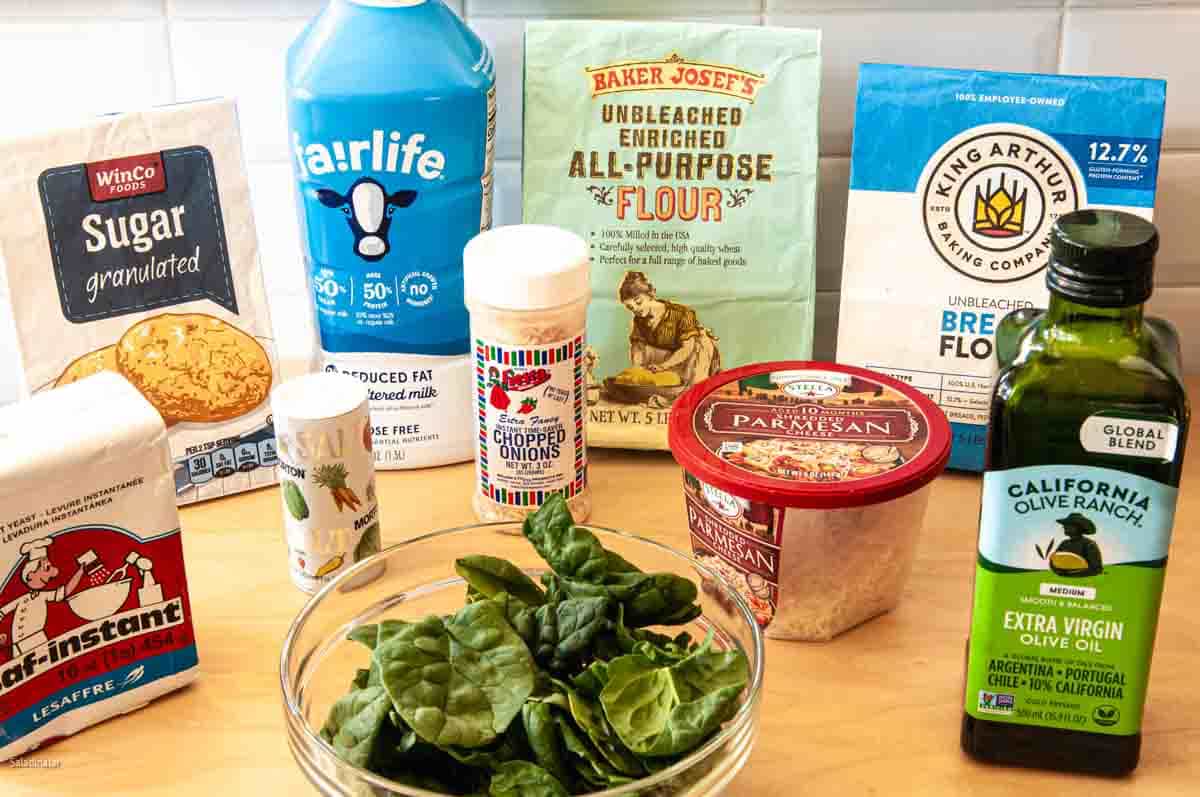
MILK: Milk adds richness to bread and helps the crust brown. You can use skim milk, low-fat milk, or whole milk, but whole milk is the best. Substitute nut milk or water if necessary. If you use water, adding a couple of tablespoons of dried milk would be nice. By the way, the liquid doesn’t have to be warmed thanks to the heat-producing friction of the bread machine paddle(s).
BUTTER: Substitute any vegetable oil if preferred. I like the flavor olive oil gives to any food containing Parmesan cheese. The butter can be used straight out of the refrigerator (not the freezer) if you chop it into tiny pieces.
SUGAR: Use granulated sugar. I’m sure you could use honey as a substitute, although I haven’t tried it myself. Honey contains more moisture, so check the dough as it kneads.
SALT: I use a table or sea salt. Reduce the salt if you must, but please don’t leave it out. Add a ¼ teaspoon more if you use Kosher salt.
SHREDDED PARMESAN CHEESE: The better your cheese, the better your bread. Another aged hard cheese like Romano would make a good substitute.
INSTANT MINCED ONION: See more information about this crucial ingredient below.
BREAD FLOUR: Bread flour contains more protein, so it develops a stronger gluten network to support this loaf. If you only have all-purpose flour, I suggest you make several small loaves instead or add Vital Wheat Gluten to the mix following the directions on the package.
INSTANT YEAST: Instant yeast is the only kind I use with a bread machine. They go together like the proverbial horse and carriage, love and marriage. If you only have active dry yeast, dissolve it in part of the liquid called for in the recipe before adding it to the ingredients in the bread machine pan. Also, use an additional ¼-½ teaspoon of active dry yeast because it can be slow to get started.
FRESH SPINACH: Fresh spinach is the best choice for this bread. Make sure it is washed and dried before chopping. Chop as finely as you can get it. You do not have to press the water out. I don’t recommend frozen spinach or cooked spinach. It’s difficult to press all the excess water out, and you risk the dough turning green. Green eggs and ham are one thing, but green bread is not what I’m going for.
What Is the Difference Between Instant Chopped Onions and Minced Onions?
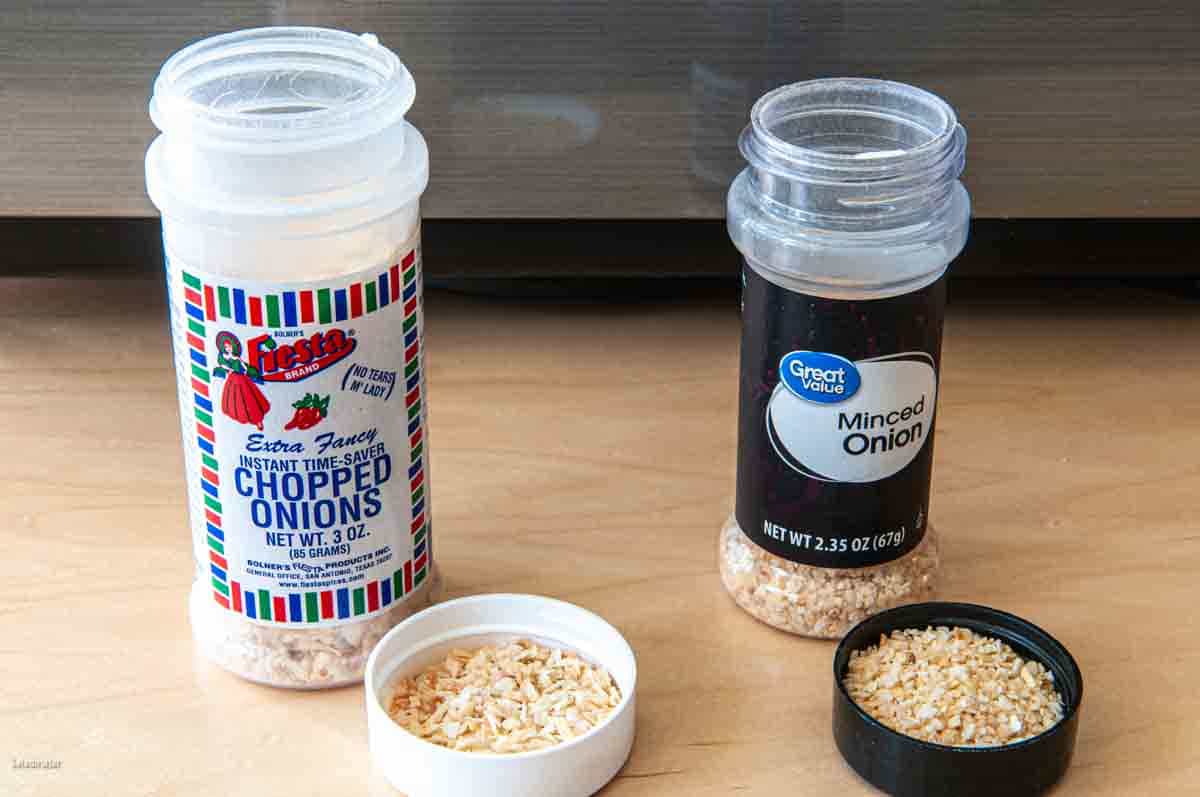
The onion flavor in this bread is distinctive and a major flavor in this loaf due to the instant chopped onions. Why use dried onions instead of fresh onions?
Three differences between instant chopped onions, dried minced onions, and fresh onions
- Dried onions eliminate the moisture problem inherent to using fresh onions.
- The flavor is more intense in dried onions. “During processing, onion flakes take on richer, sweeter, toastier flavor than fresh onions.”
- Look for dehydrated chopped onions as opposed to dried minced onions, which are smaller in size and not as flavorful. In most recipes, it might not matter, but the larger dehydrated chopped onions are prettier in the baked bread.
Spelt Version of Spinach Bread
Would you like to add some spelt or whole-grain flour to this loaf? I have fallen in love with spelt whole grain flour in the last year. The taste is milder than the regular whole wheat flour you find at the local grocery store. Unfortunately, most grocery stores don’t carry it. I buy mine at Winco, where they stock it in the bulk-bin section. You can always order spelt flour (paid link) from Amazon.
- Substitute 1 cup (120 g) finely ground spelt whole grain flour for 1 cup (120 g) of bread flour.
- You may need to add more water. Determine if it’s necessary by observing the dough as it kneads near the end of the kneading cycle.
- When using spelt, I prefer to substitute two tablespoons of olive oil for the butter and one tablespoon of honey for the sugar, but this is strictly my preference and not required.
How To Make the Dough for Bread Machine Spinach Parmesan Bread
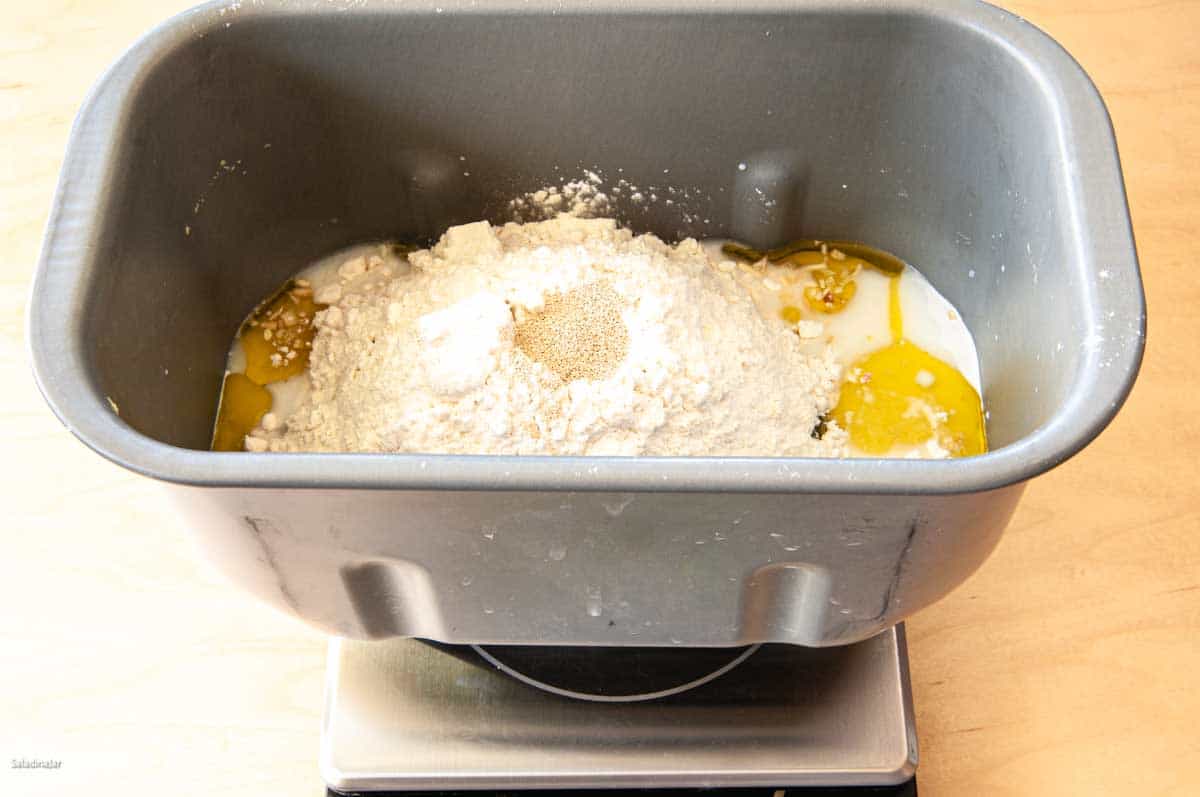

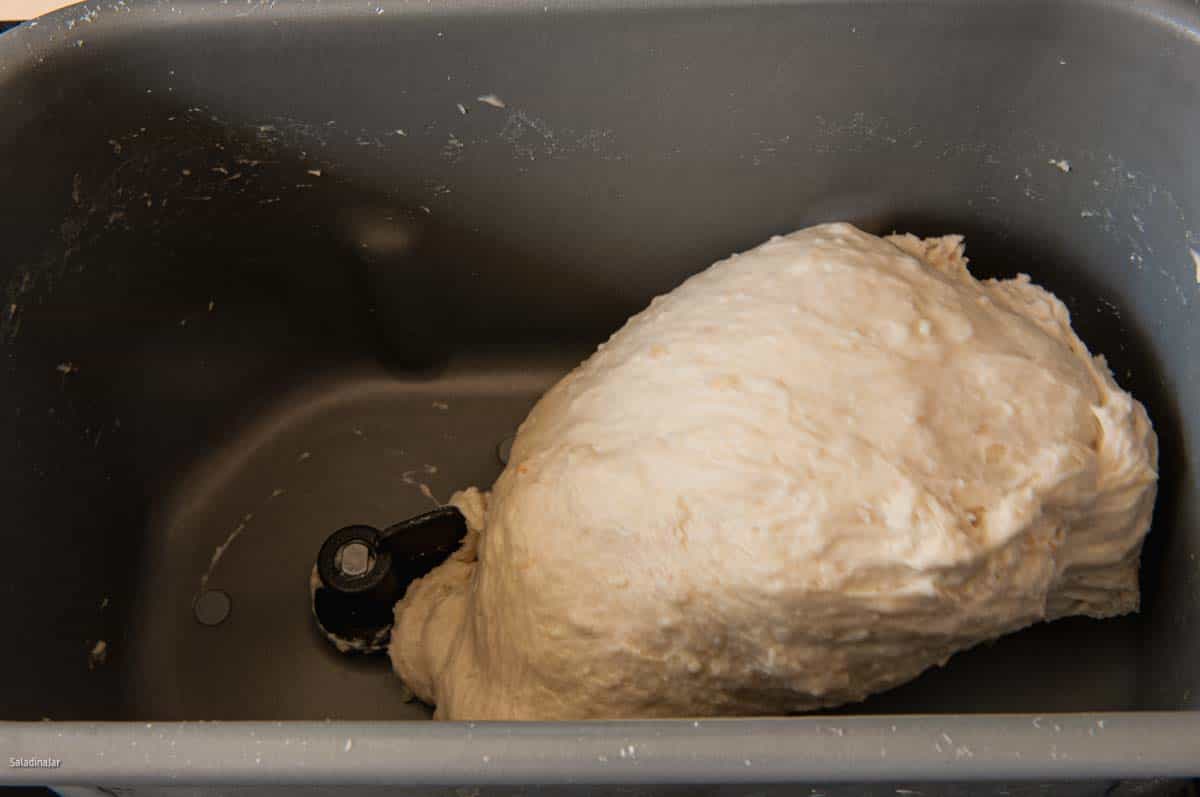
If the dough bounces off the sides or rides around on top of the post(s), add more water, one tablespoon at a time, allowing a couple of minutes for the water to absorb before adding more.
If the dough is very sticky and won’t pull away from the sides, add more flour, one tablespoon at a time, allowing a couple of minutes before adding more to allow the dough to absorb the flour. Read more about this secret to making better bread with a bread machine.
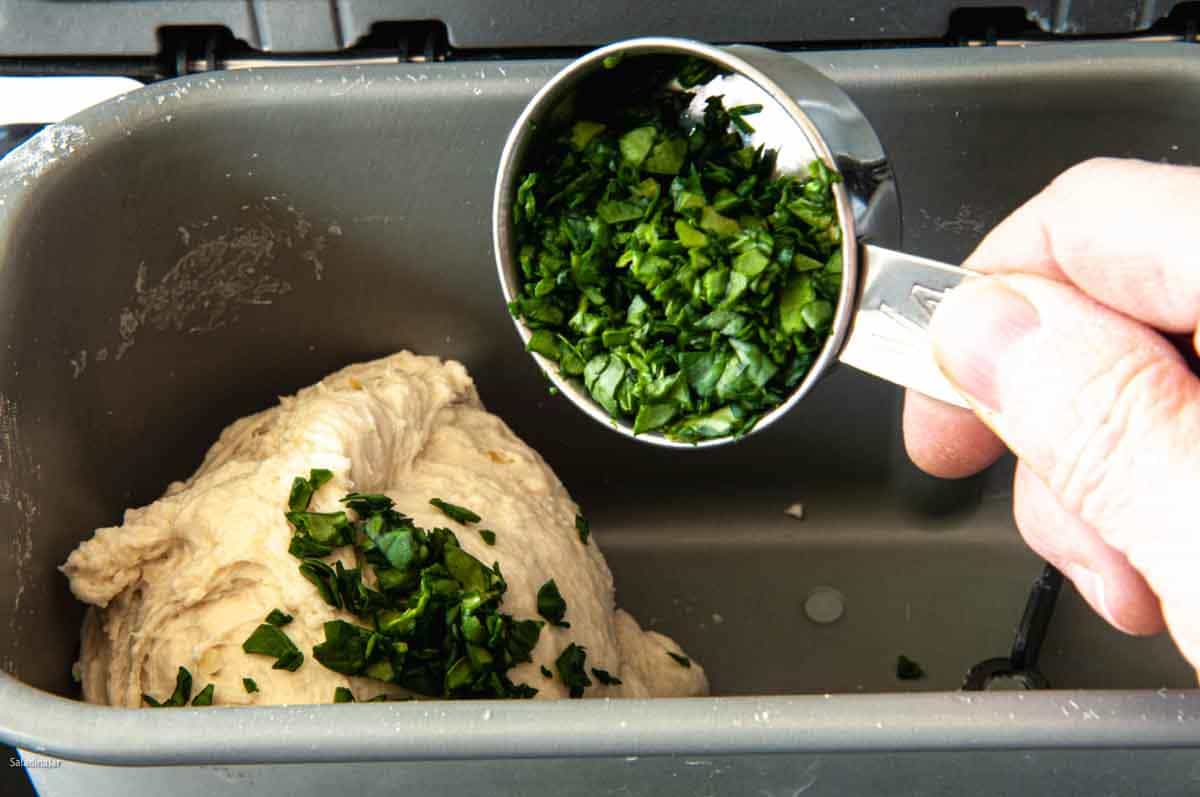
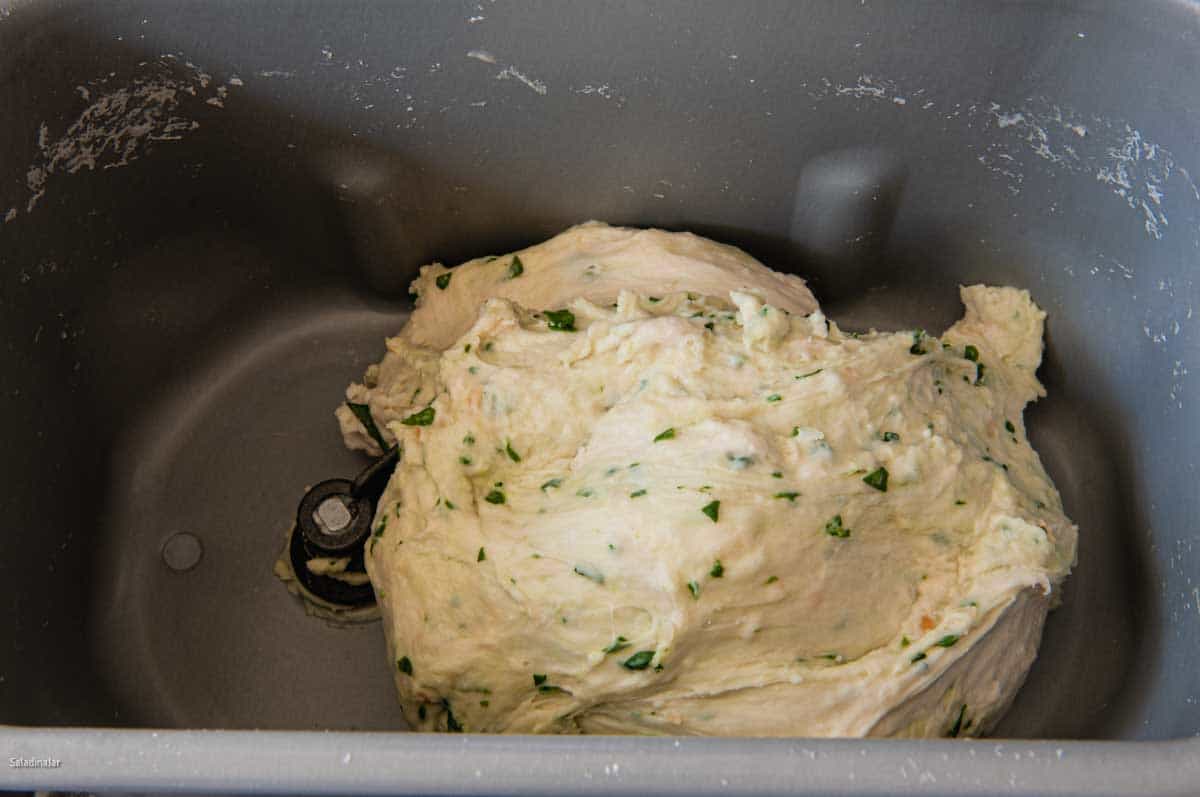
Shaping the Dough
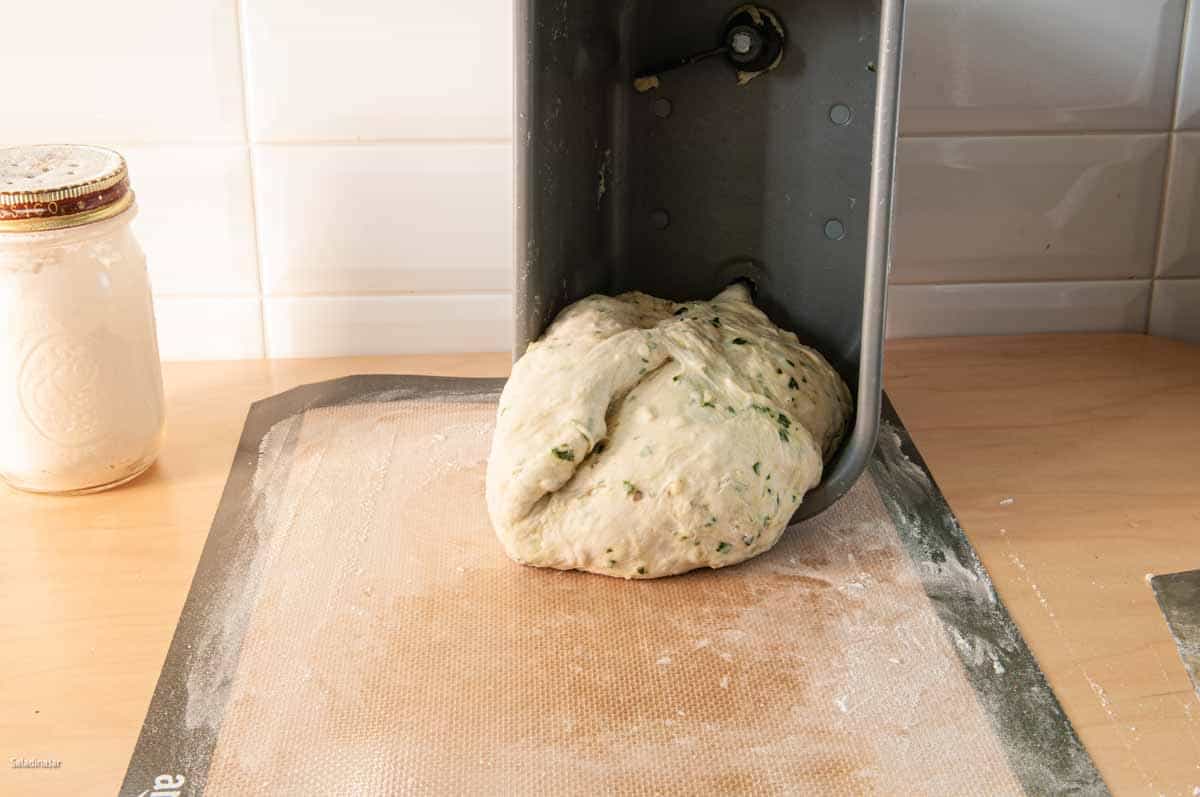
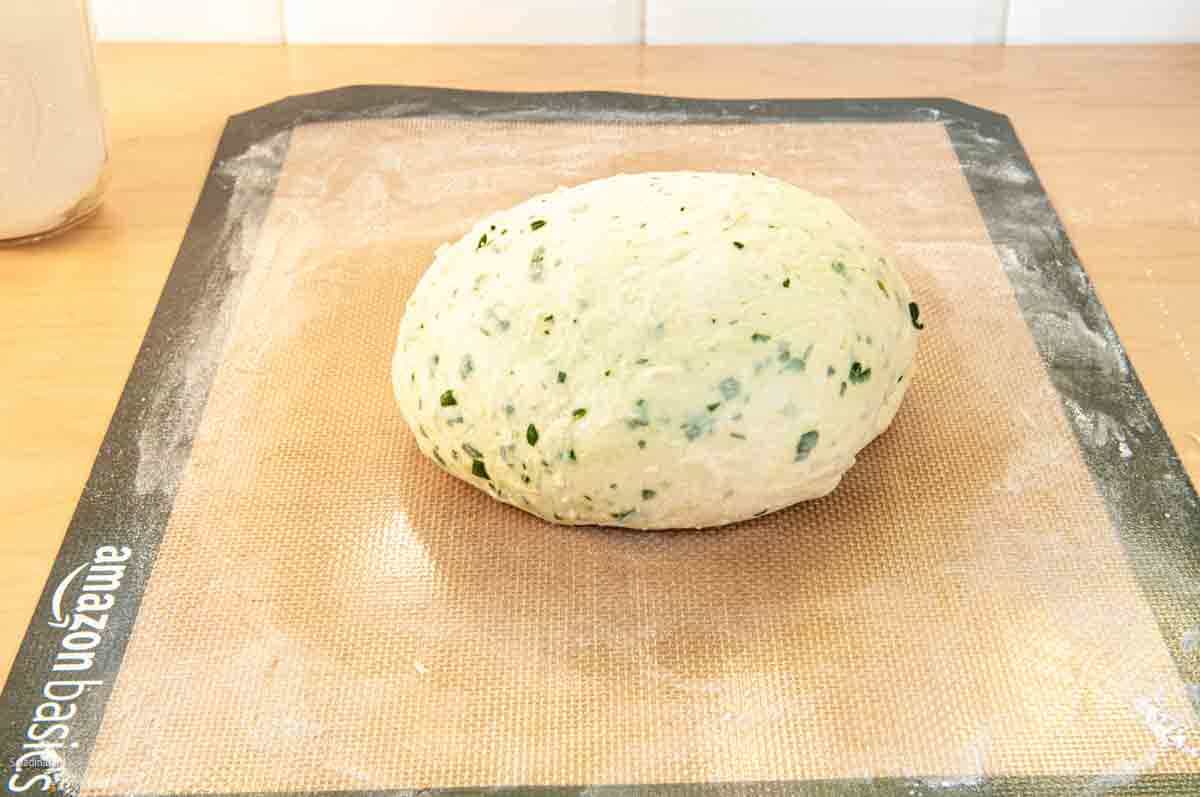
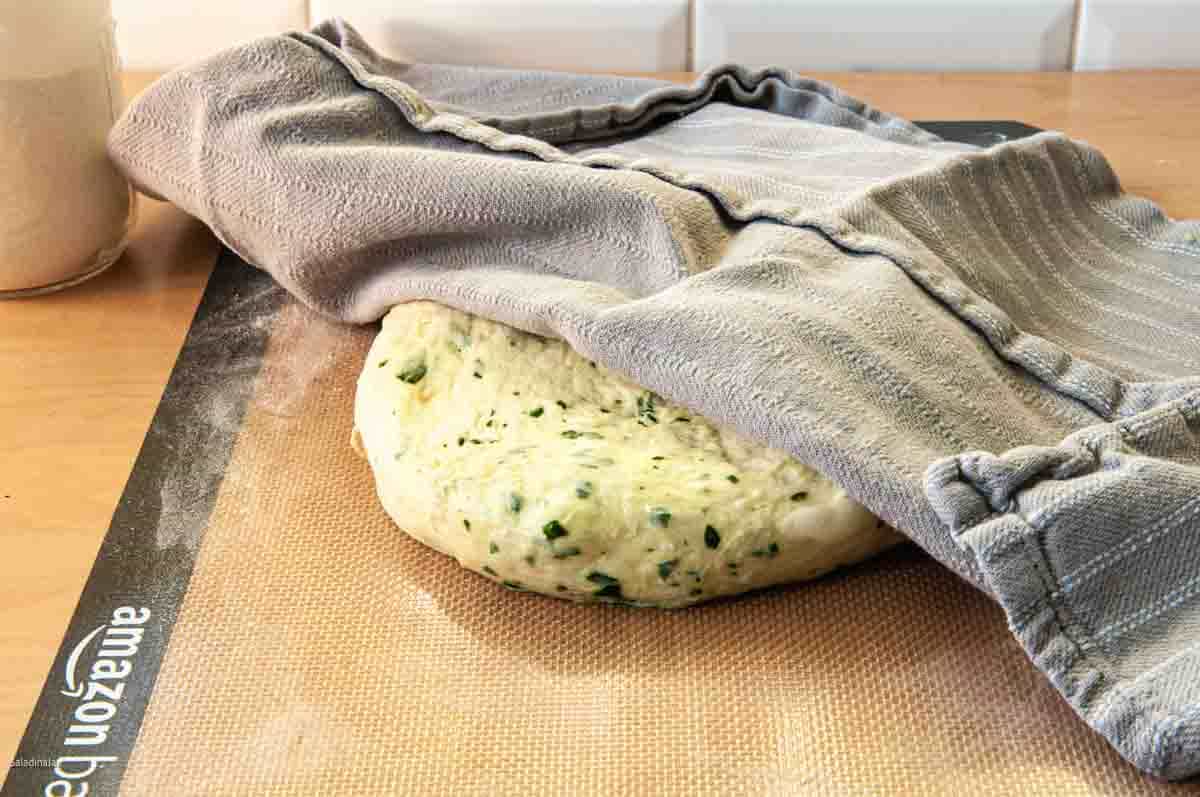
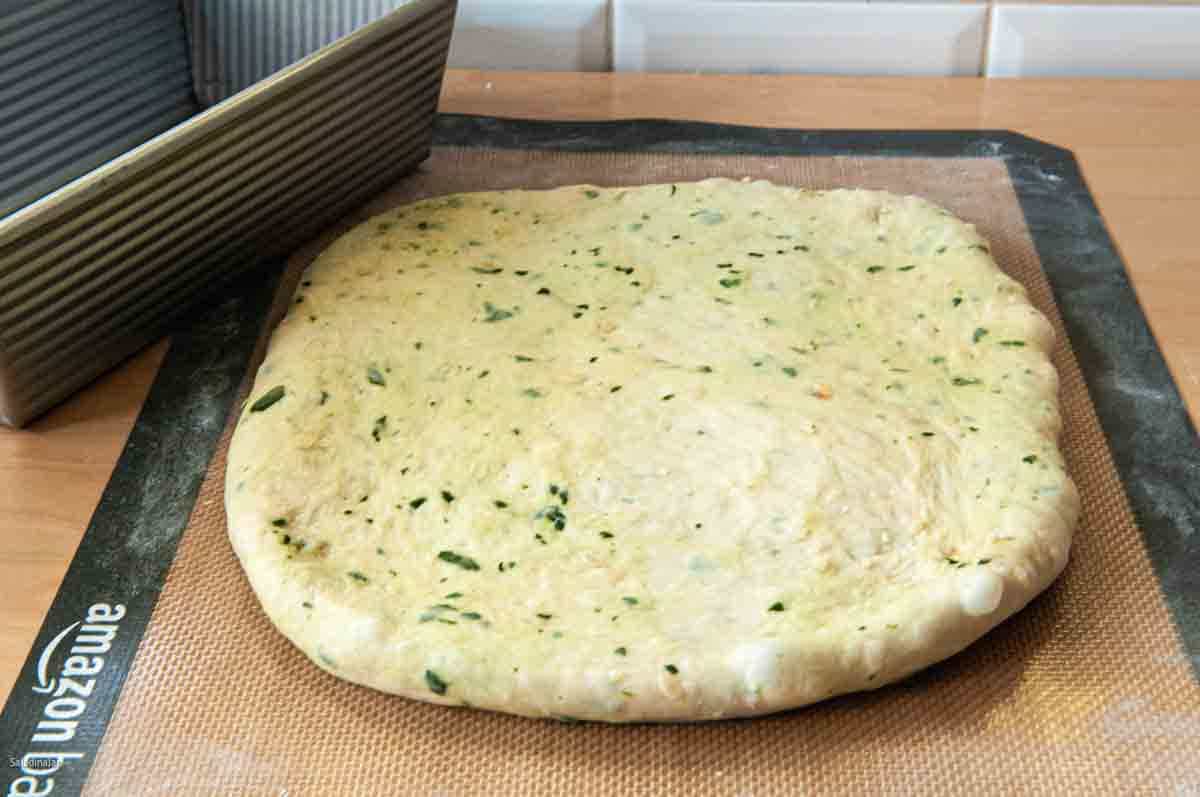
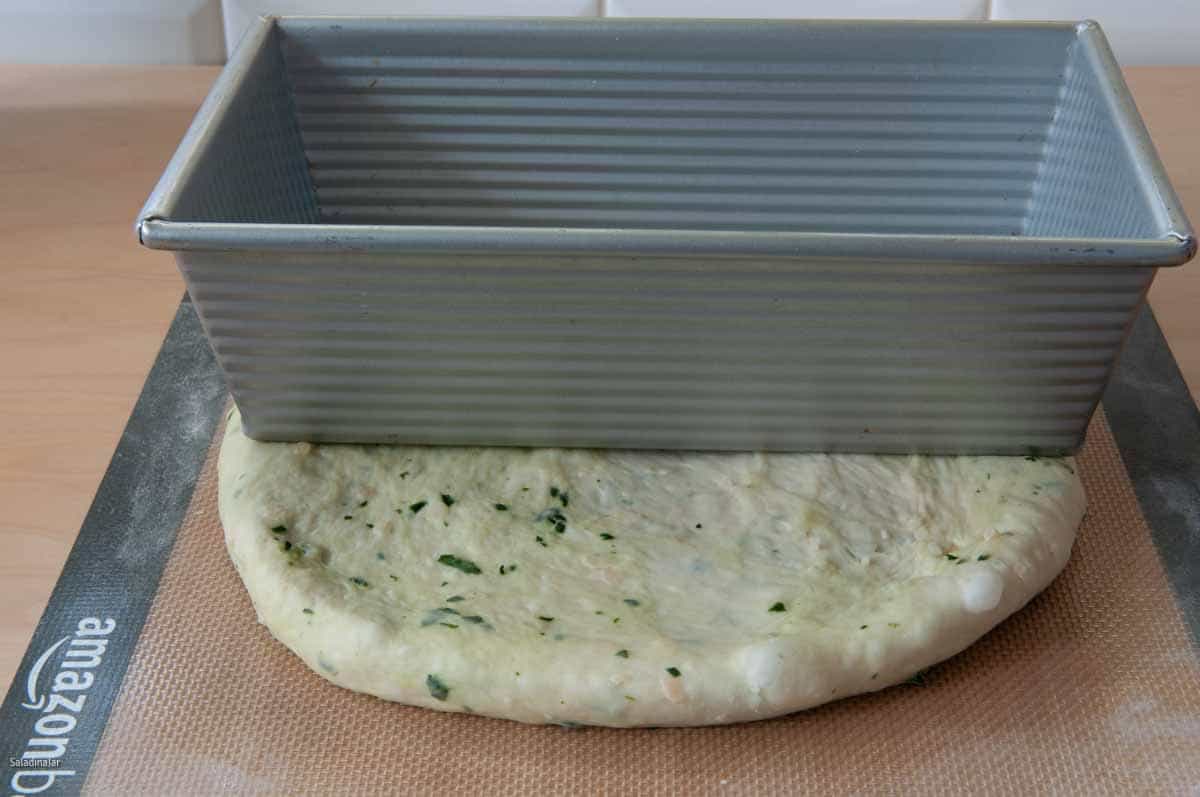
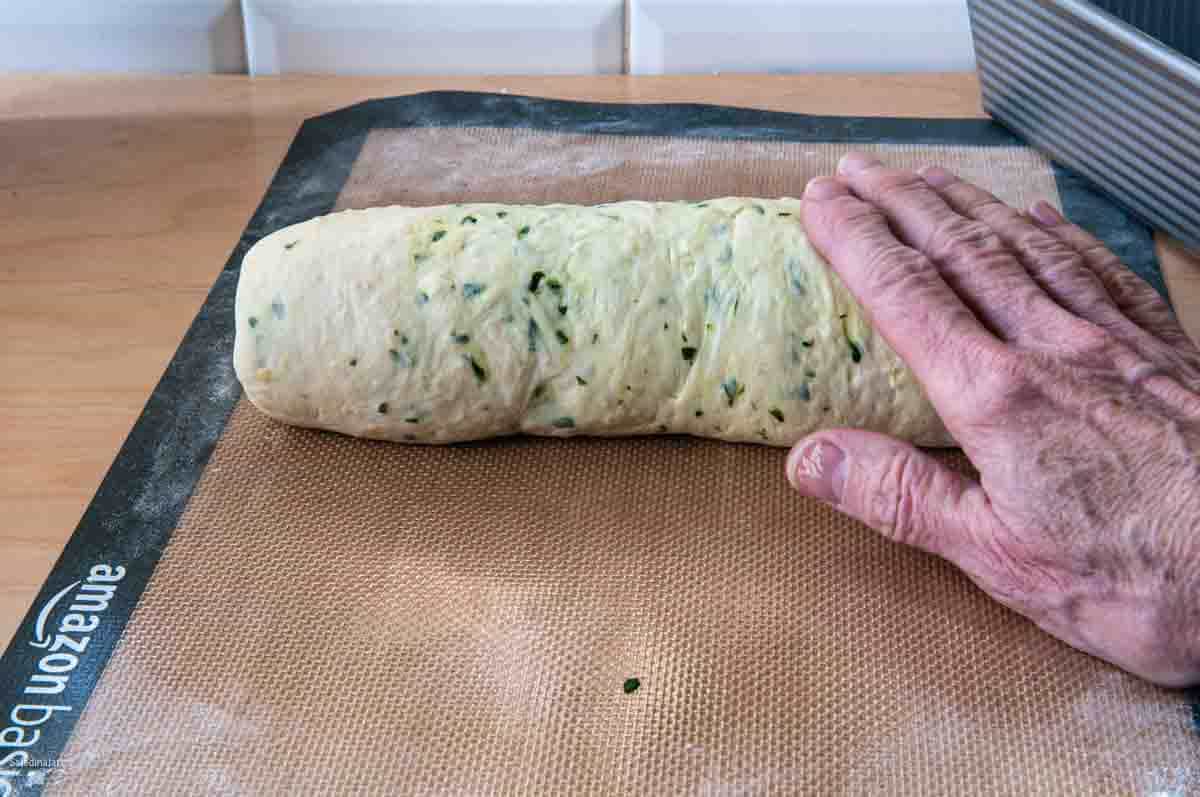
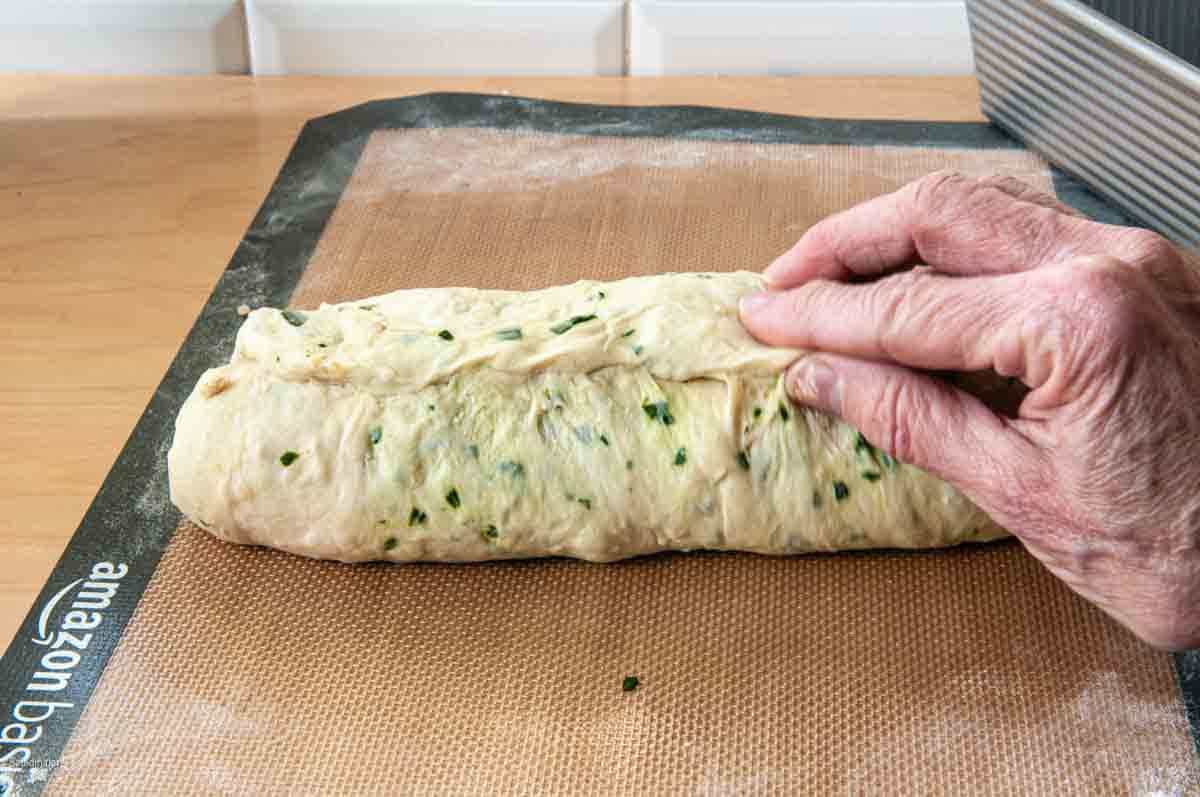
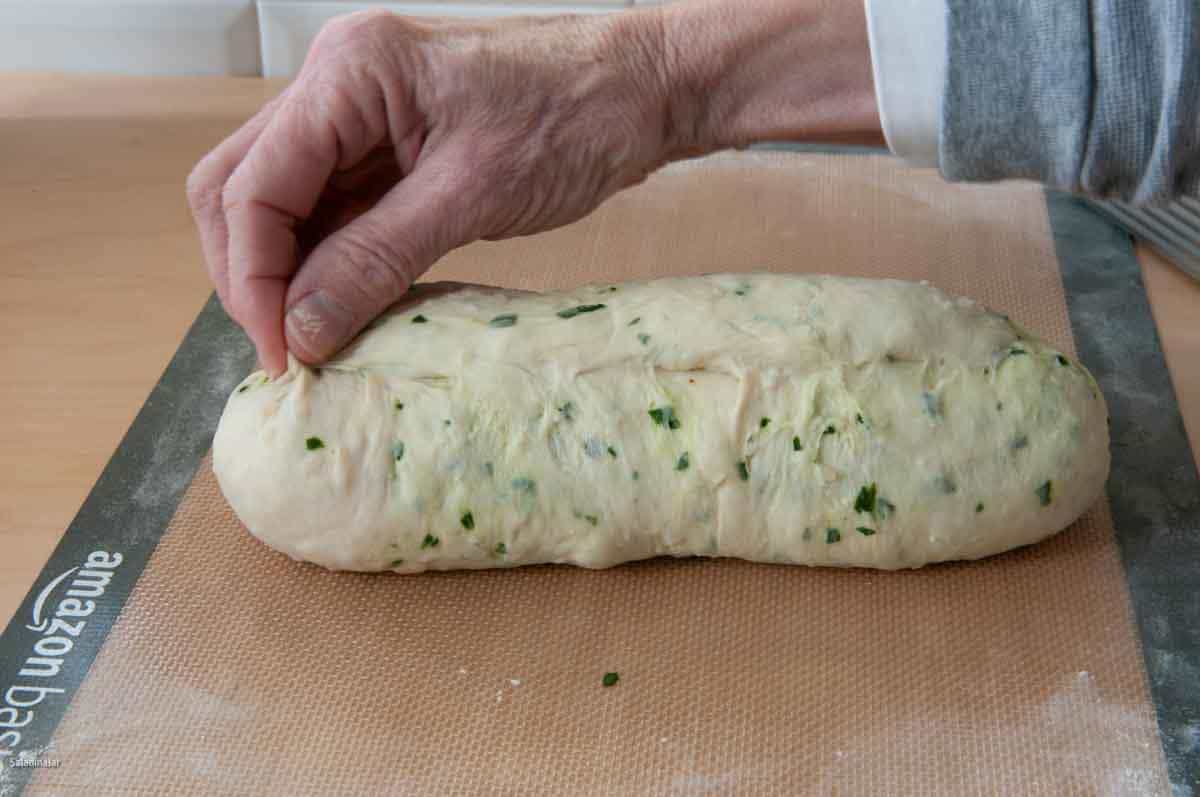
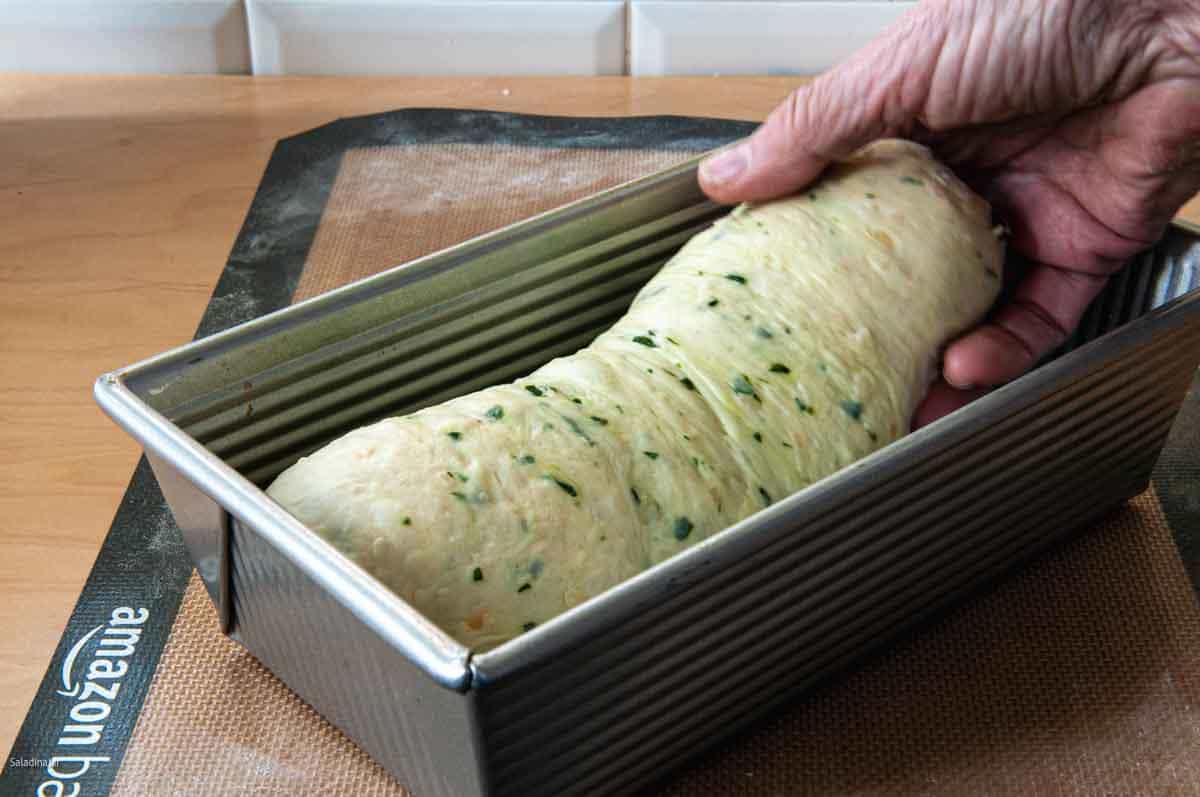
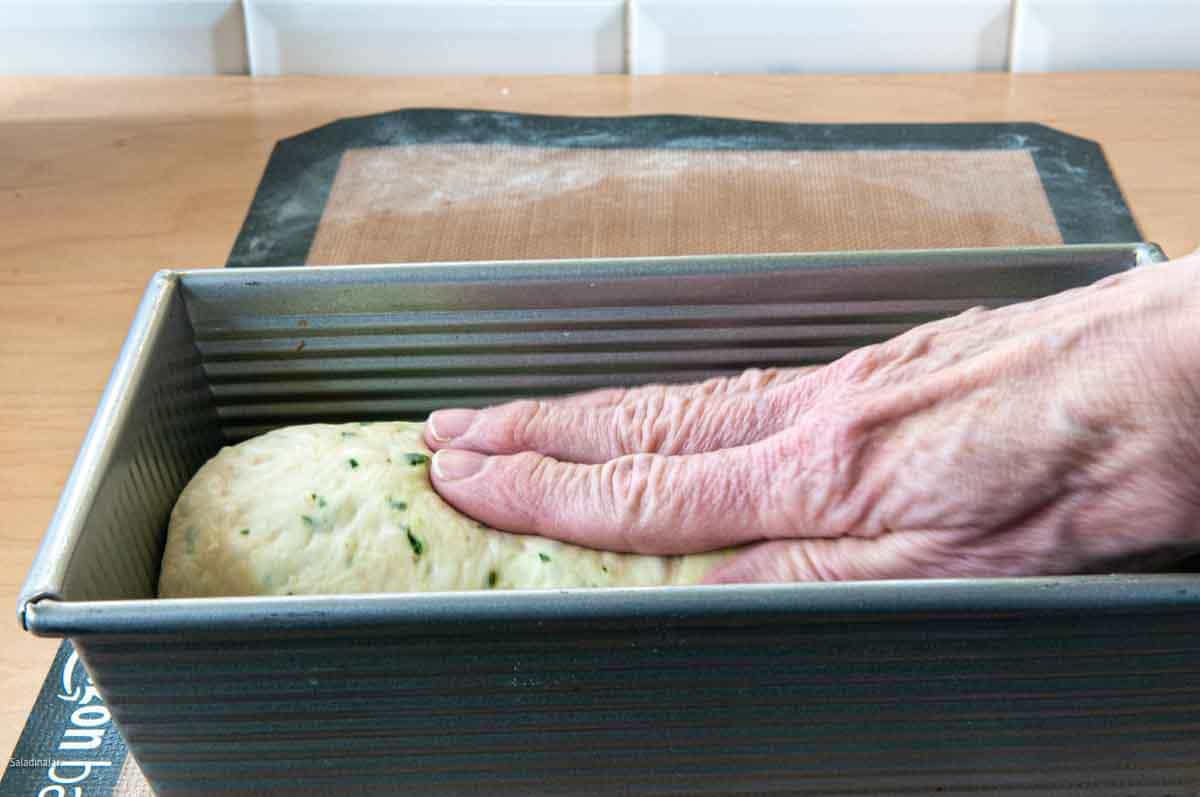
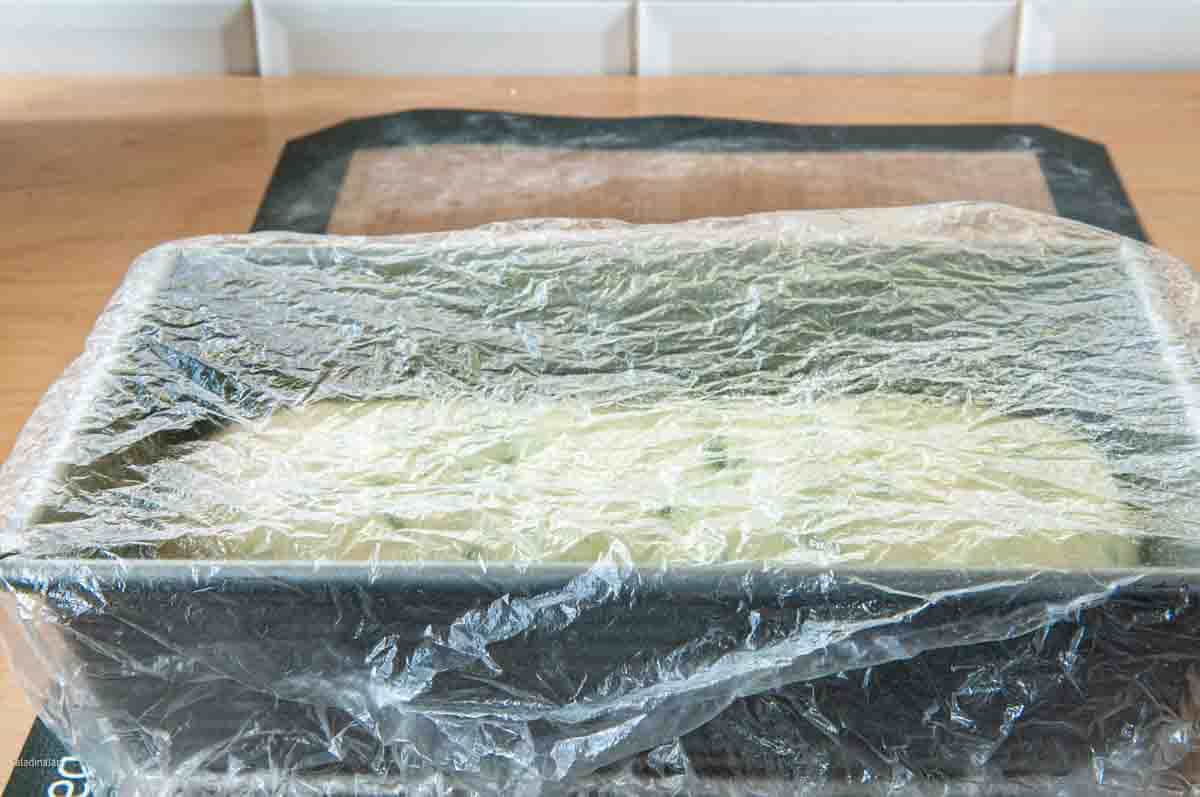
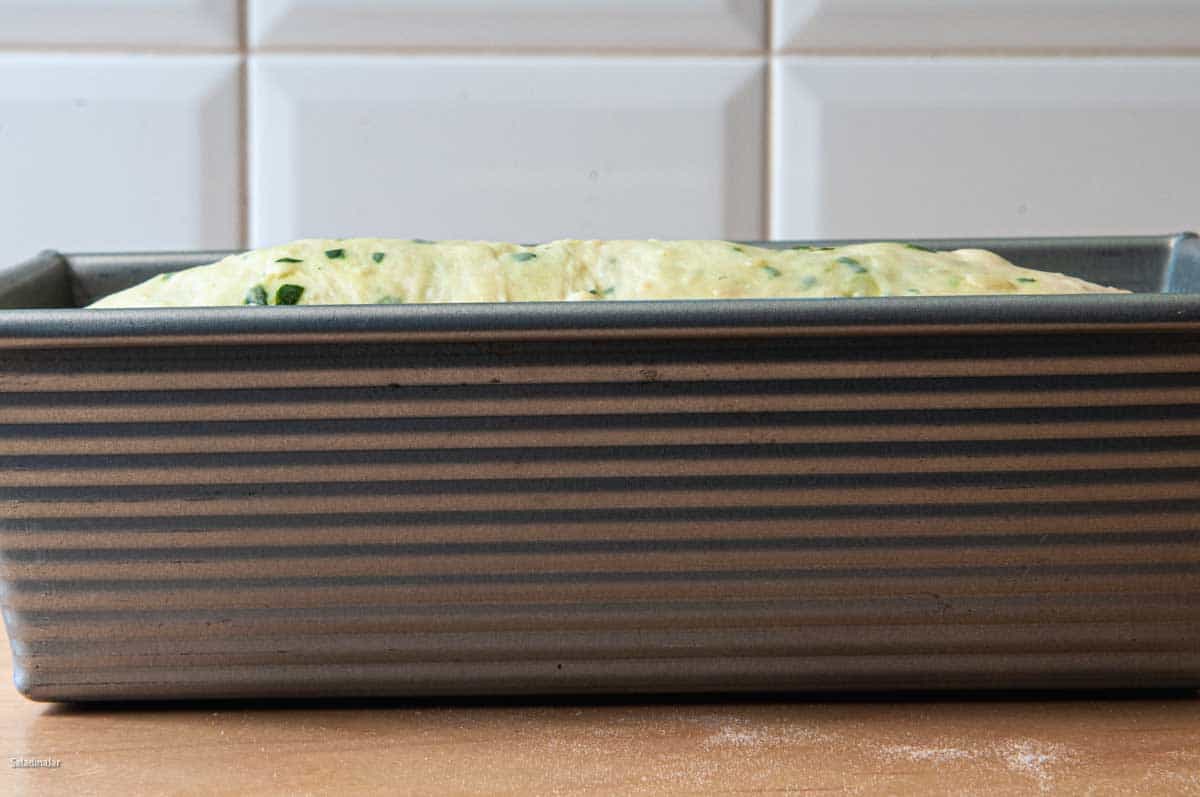
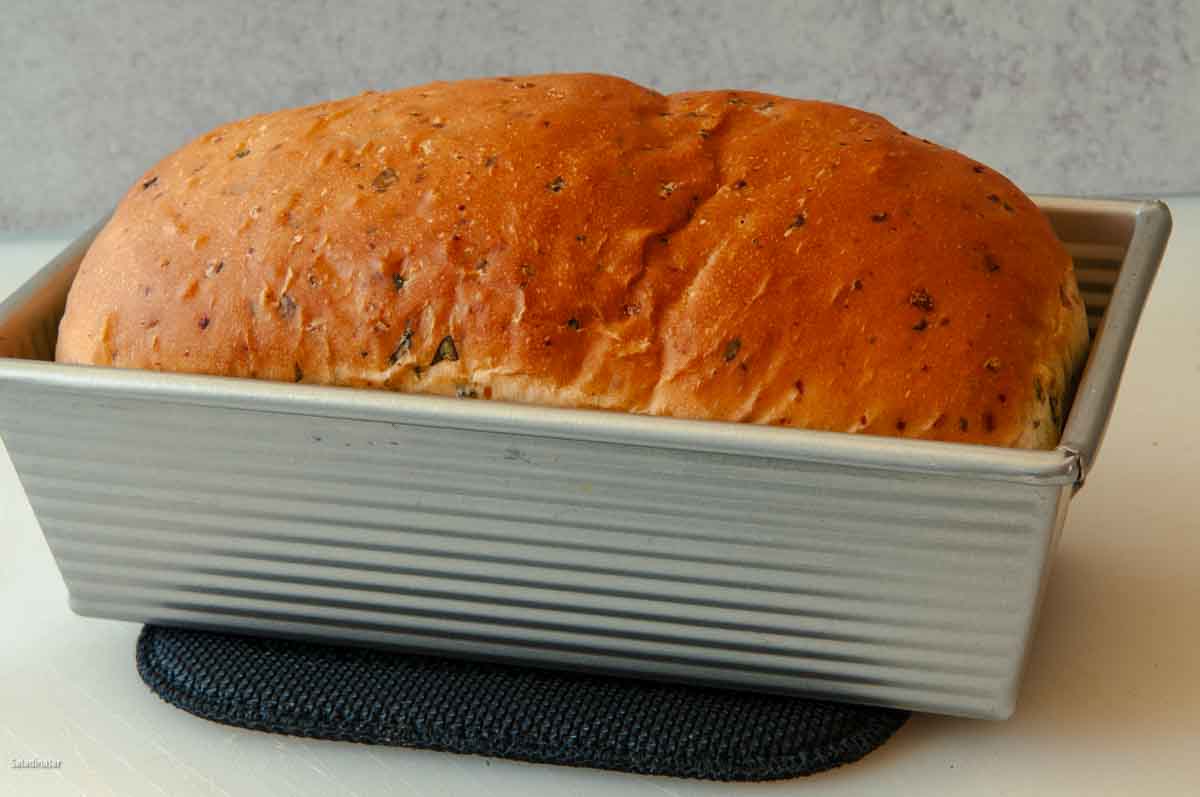
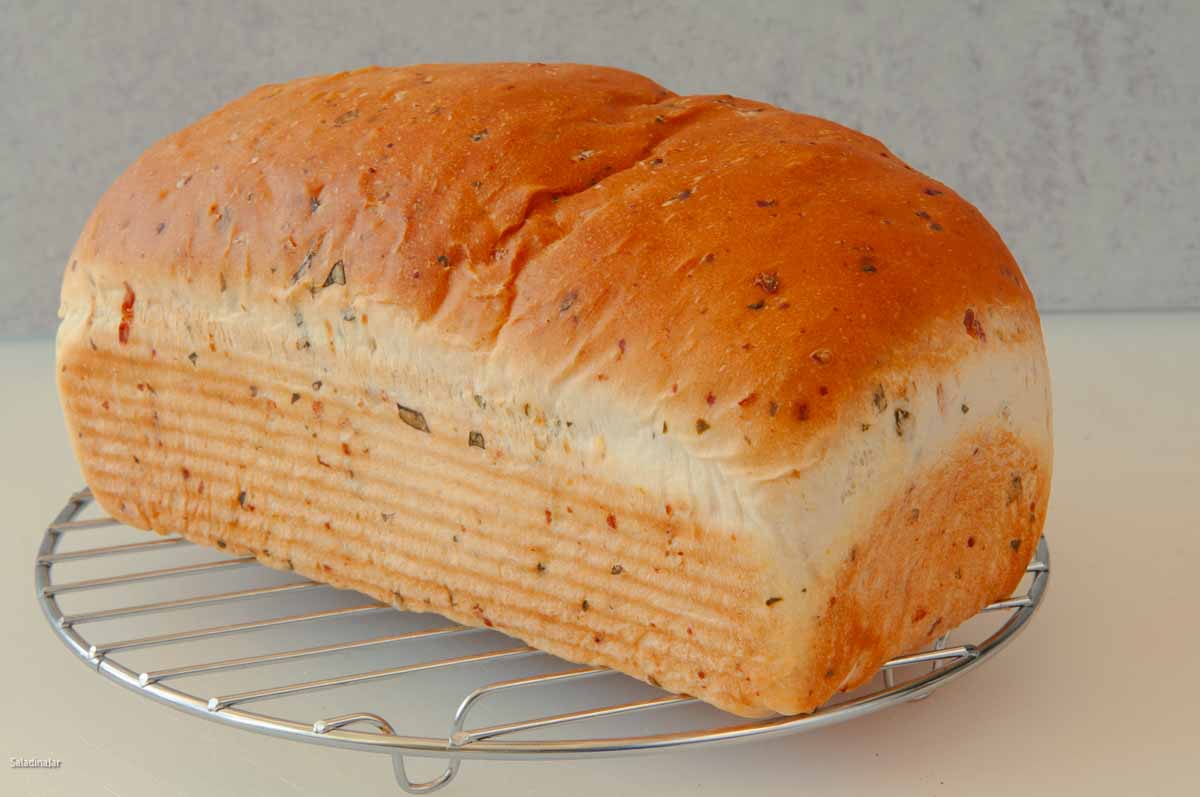
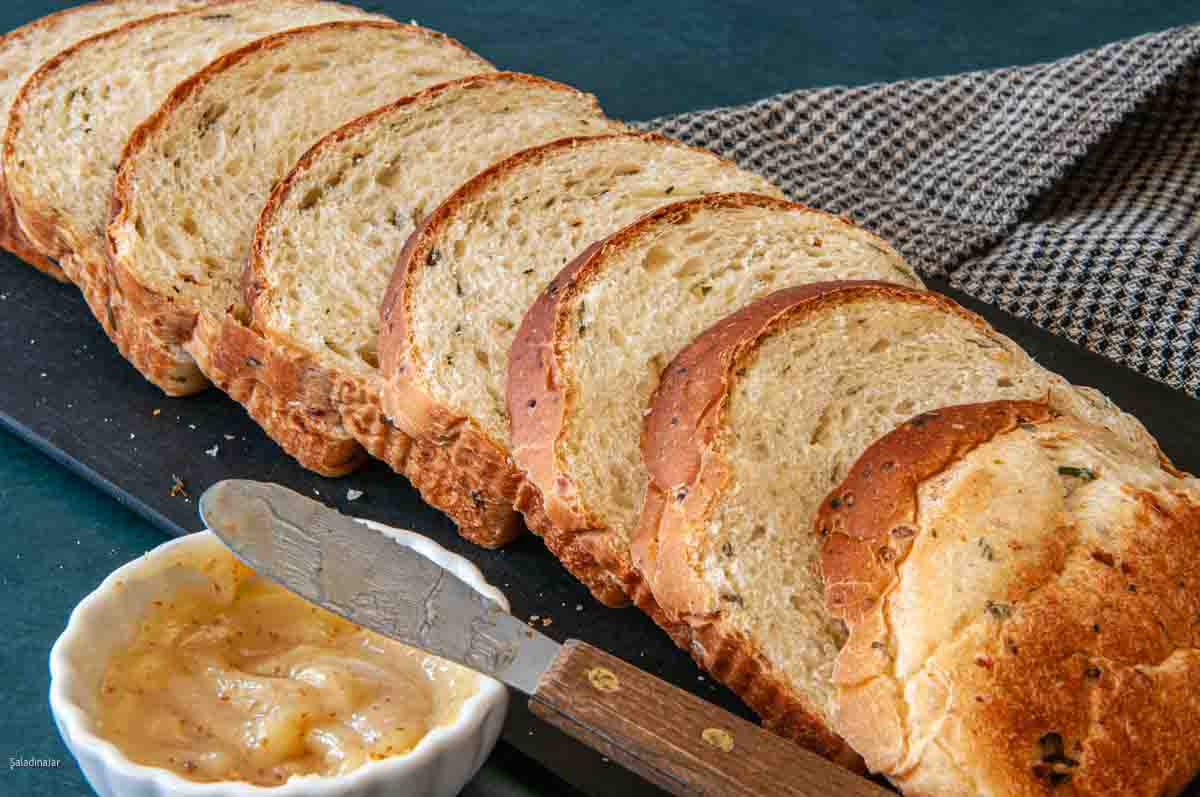
FAQ About Spinach Bread with Parmesan
After removing the dough from the bread machine pan, place the dough in a clean bowl that allows enough room for the dough to rise to double its size. The next day, allow the dough to warm until pliable. Compress, shape, and place it in your loaf pan. Allow to rise one more time and bake per the directions.
Yes, but blot it with paper towels after chopping it to absorb excess moisture. I prefer fresh spinach as it is easier to control the moisture.
Double wrap and freeze it after a day or two. The refrigerator is too humid and encourages mold.
Recipe Help at Your Fingertips: For questions or suggestions, email Paula at saladinajar.com. If you need help, I’m happy to troubleshoot via email (faster than leaving a comment). Attach pictures and as many details as possible for the best advice.
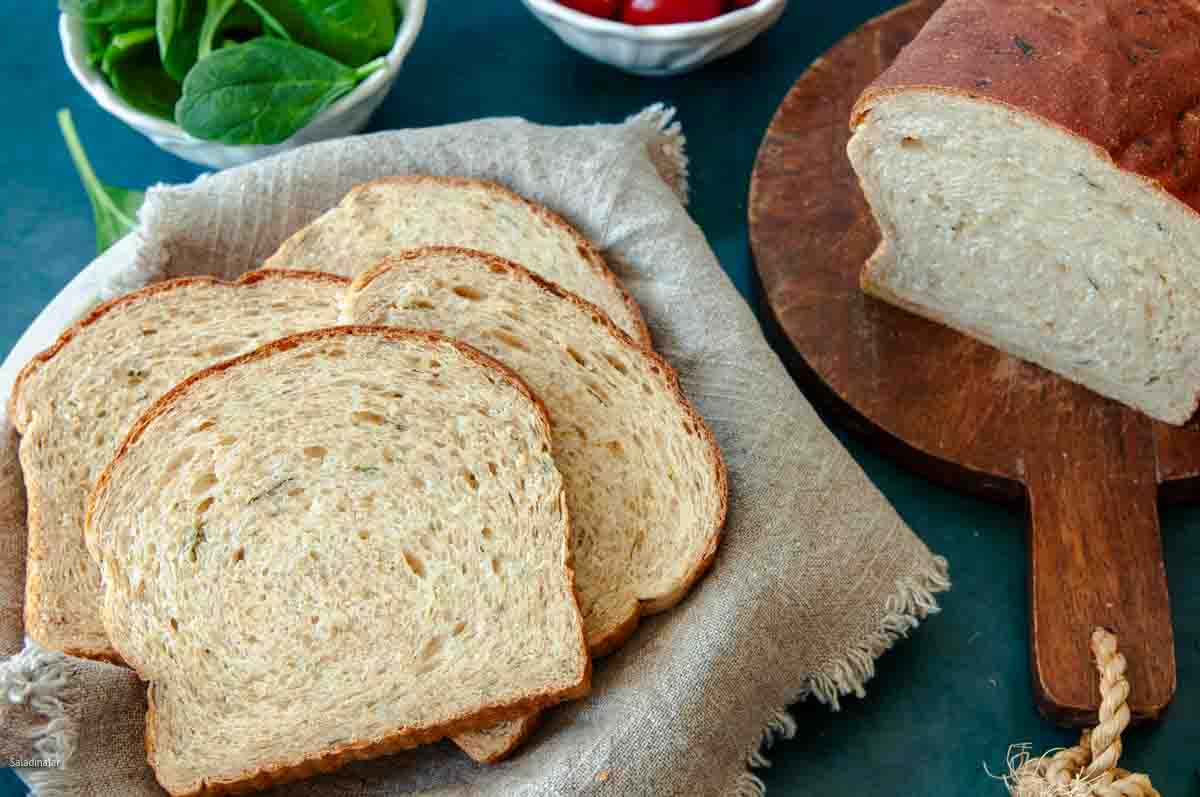
Spinach Bread with Parmesan: A Bread Machine Miracle
Rate this recipe
(5 stars if you loved it)
Video
Ingredients
- ½ cup (114 g) milk
- ⅔ cup (150 g) water
- 2 tablespoons (28 g) butter
- 1 tablespoon granulated sugar
- 1 teaspoon salt
- ¼ cup (27 g) grated Parmesan cheese
- 1½ tablespoon (10 g) instant minced onion
- 3 cups (360 g) bread flour
- 1½ teaspoons instant yeast
- ¼ cup (15 g) finely chopped fresh spinach leaves
Instructions
Dough
- Place ½ cup (114 g) milk, ⅔ cup (150 g) water, 2 tablespoons (28 g) butter, 1 tablespoon granulated sugar, 1 teaspoon salt, ¼ cup (27 g) grated Parmesan cheese, 1½ tablespoon (10 g) instant minced onions, 3 cups (360 g) bread flour, and 1½ teaspoons instant yeast into the bread machine pan. If possible, weigh the flour.
- Select the DOUGH cycle and press START.
- Open the lid and check the dough after it has mixed for 1-2 minutes. Ensure the paddle(s) is engaged, and the dough is starting to clump into a ball.
- After 15-18 minutes, open the lid again and check the moisture level of the dough. It should be sticky enough to stick to the sides, then pull away cleanly. If the dough is bouncing off the pan walls or riding on top of the paddle like a top, add more water one tablespoon at a time until the dough is slightly tacky.
- If the dough is too wet, and doesn’t pull away from the sides cleanly, add flour one tablespoon at a time. Read more about this surprising trick for making good bread in a bread machine.
- When the machine beeps that it’s time for add-ins, add ¼ cup (15 g) finely chopped fresh spinach leaves to the dough. If your machine doesn’t have a beep, add it in the last 3-4 minutes of the kneading phase.
Shaping
- When the DOUGH cycle completes, check to ensure the dough has doubled in size. If not, leave it in the machine to rise until it does. When doubled, remove the dough to a lightly floured surface. (I use a floured silicone mat for easy cleanup.)
- Knead lightly and shape into a smooth round ball.
- Use your hands and a rolling pin to roll into a rectangle approximately 9×11 inches. Make sure any large, visible bubbles are pressed out.
- Starting with the short end closest to you, begin rolling the dough to make a loaf. Don’t stretch the dough or leave spaces between the layers. Pinch the seam shut. Then, pinch the ends shut and pull them towards the seam. If you are confused, watch the video.
- Grease the pan beforehand unless otherwise instructed by the manufacturer. Place the dough into a 9 x 5-inch loaf pan with the seam side down. Use your flat palms to gently but firmly press the dough into the pan as evenly as you can.
- Cover with a cheap shower cap or tea towel and let the dough rise in a warm place (75-78˚F) until the dough peeks over the edge of the pan no more than 1 inch. Preheat your oven to 350˚F about 15 minutes before you think the bread will be ready to bake.
- Bake at 350˚F for 35 minutes or until the internal temperature reaches 200˚F.
- Allow the loaf to cool for 15 minutes before turning the bread onto a cooling rack. Let the loaf cool for at least an hour before slicing.
Notes
- In a heavy-duty stand mixer, add the ingredients to the bowl in the specified order.
- Begin mixing on low speed until all the ingredients are moistened.
- Switch to a dough hook attachment and increase the speed to 2 or 3.
- Continue beating/kneading until the dough becomes smooth and elastic, typically about 5-10 minutes.
- Cover the dough and let it rise in a warm place.
- Once risen, gently deflate the dough and shape it as directed in the recipe.
- Combine all the ingredients in a large bowl until they form a shaggy ball.
- Turn the dough out onto a floured surface.
- Knead the dough with your hands until it becomes smooth and elastic, which may take around 10-20 minutes, depending on your experience.
- Place the dough ball in a greased bowl.
- Cover the bowl and allow the dough to double in size.
- After rising, gently deflate the dough and shape it according to the recipe’s instructions.
Equipment
Nutrition
All images and text ©️ Paula Rhodes for Salad in a Jar.com

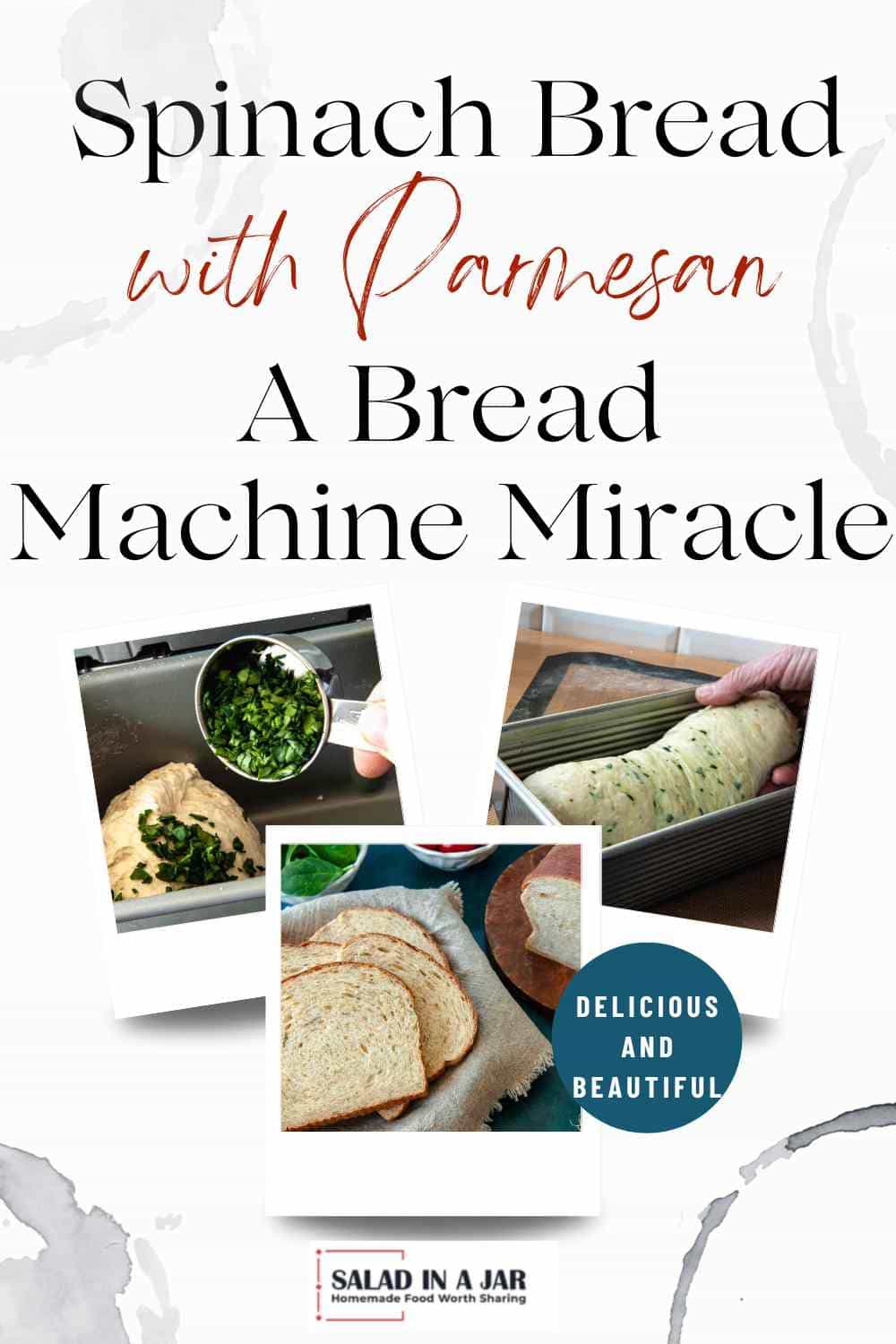
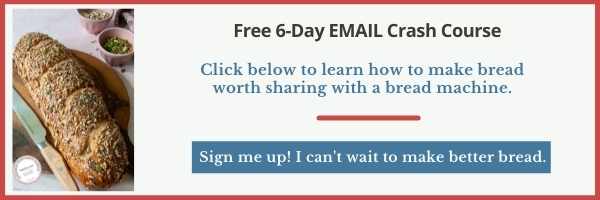
Paula Rhodes, owner
As a retired home economist, I created Saladinajar.com to share my belief that you don’t have to be a chef to find joy in creating homemade food worth sharing. Bread machines (used in an unconventional way), homemade yogurt, and quick microwave recipes are my specialty.